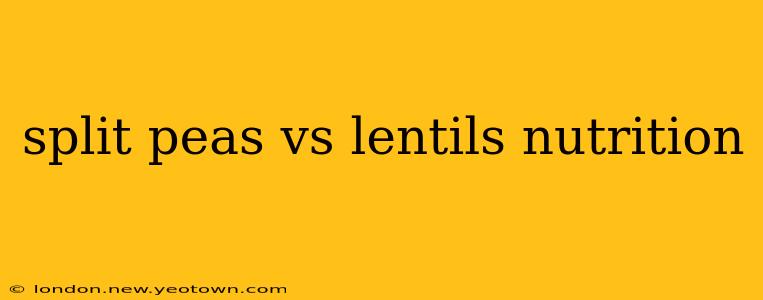The legume family boasts a wealth of nutritious options, and split peas and lentils often top the list for their versatility and health benefits. But when it comes to choosing between these two powerhouses, which one reigns supreme? Let's dive into a head-to-head comparison, exploring their nutritional profiles and uncovering which might be the better fit for your dietary needs.
Our story begins in a bustling farmer's market, where a vibrant display of legumes catches our eye. A friendly farmer, noticing our indecision between a bag of plump green lentils and a sack of creamy split peas, offers to share his wisdom. "Each has its own strengths," he explains, "It's all about understanding what your body needs."
What are the Nutritional Differences Between Split Peas and Lentils?
This is where the real comparison begins. Both split peas and lentils are excellent sources of plant-based protein, fiber, and various micronutrients. However, subtle differences in their nutritional composition exist:
| Nutrient | Split Peas (1 cup cooked) | Lentils (1 cup cooked) |
|---|---|---|
| Calories | ~230 | ~230 |
| Protein (grams) | ~16 | ~18 |
| Fiber (grams) | ~16 | ~15 |
| Iron (mg) | ~6 | ~6.6 |
| Folate (mcg) | ~180 | ~177 |
| Potassium (mg) | ~700 | ~730 |
As you can see, the caloric and protein content is remarkably similar. Both are packed with fiber, crucial for digestive health and blood sugar regulation. Lentils may boast a slight edge in iron and potassium.
Are split peas or lentils better for weight loss?
Both split peas and lentils are low in fat and high in fiber, making them excellent choices for weight management. The high fiber content promotes satiety, helping you feel fuller for longer and potentially reducing overall calorie intake. The slight difference in calories and fiber content is unlikely to significantly impact weight loss efforts; choosing either is a healthy option.
Which is higher in protein?
While the difference is minimal, lentils generally contain slightly more protein per serving than split peas. This distinction is rarely significant unless you are on a very strict high-protein diet.
Which legume has more fiber?
Split peas typically have slightly more fiber than lentils. This translates to better digestive health and potentially lower cholesterol levels. Again, the difference isn't drastic.
Which is easier to digest?
This is a matter of personal experience. Some individuals find lentils easier to digest than split peas, while others have the opposite experience. The cooking method also influences digestibility; properly cooked legumes are generally easier on the stomach.
What are the best ways to cook split peas and lentils?
Both split peas and lentils are incredibly versatile. They can be cooked into soups, stews, dahls, or added to salads and side dishes. Split peas lend themselves well to creamy soups and purees, while lentils hold their shape better and are great additions to curries and vegetable dishes. Experiment and find what works best for your palate!
Conclusion: It's a Tie (Almost!)
The farmer's wisdom proves true: both split peas and lentils are nutritional powerhouses, offering a wealth of health benefits. While minor differences in nutrient composition exist, the choice often comes down to personal preference and the specific recipe. Don't hesitate to incorporate both into your diet to reap the rewards of their diverse nutritional profiles. The real winner? Your health!

